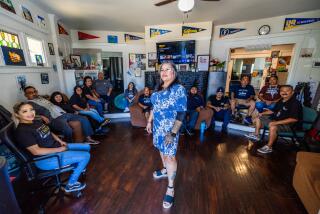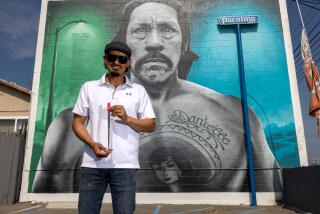Unveiling of Unity Sign Reveals Tensions in City
- Share via
As federal prosecutors called their first witnesses in the Rodney G. King civil rights trial, a billboard aimed at promoting racial harmony was unveiled at the flash point of last year’s devastating riots.
The image is of hands--black, brown, yellow and white--clasped in unity above a sparkling Los Angeles skyline. Twenty such billboards have been erected around the city, part of Mayor Tom Bradley’s community involvement Neighbor to Neighbor program.
But a news conference Friday to promote the program, which Bradley attended, yielded equally compelling images of a city that is still tightly wound with doubt and apprehension, underscoring the difficulty of bringing about real healing.
One young man pushed through reporters gathered at the rain-washed gas station at Florence and Normandie avenues, confronting the mayor about alleged police abuses.
“What are you doing to stop police brutality from going on on a daily basis in this community?” demanded the man, a widely quoted ex-gang member who goes by the nickname Li’l Monster.
Bradley’s reply was calm and measured. The city is working to repair antagonistic relations, he said.
“Chief (Willie L.) Williams has literally transformed the Police Department and its conduct,” Bradley said steadily. “If we hear from you and you give us specifics, I am sure we can help you.”
But the response did not placate Li’l Monster.
“Nobody comes down here to campaign. Nobody comes down hear to listen to the community unless it’s something like this, to unveil a billboard,” he said after Bradley had departed. “The problems around here are police brutality and high unemployment and the Neighbor to Neighbor (program) can’t stop that. It’s a joke.”
To the program’s organizers, Li’l Monster’s comments were a discomfiting reminder of just how far they have to go to persuade residents of their sincerity--and to achieve the goal of bringing about community cooperation and strength. In some neighborhoods, flyers have surfaced urging residents not to “snitch” on each other, apparently aimed at derailing Bradley’s program by casting it as a police operation.
“We live and work in this community, too,” organizer Gregory Binion told Li’l Monster in what turned into an impromptu recruiting session. “But we need people like you to be become involved.”
The two exchanged numbers, with Li’l Monster vowing to be open-minded about efforts to unite the community.
A few feet away, oblivious to the confrontation, Roy Stringer, 34, homeless, unemployed for eight years and an ex-con, directed cars into the service aisles hoping for a few dollars in exchange for pumping gas.
On April 29, the evening the riots broke out, he was in prison, serving a sentence for violating parole on a robbery conviction--a crime he refers to as “surviving.”
Aside from the billboard, he has seen little else rebuilt in his decaying neighborhood since then. People in the community are nervous, he said, shivering in a tattered corduroy jacket. None want to see a repeat of the violence that wrecked so many lives, he said. Yet they are looking to see justice rendered--in the King trial and also in the upcoming trial of three young men accused of the attempted murder--only a few yards away--of trucker Reginald O. Denny at the riot’s outset.
“If police don’t receive sentences . . . and the young group does, it will be like a political hanging, that’s the way black people will see it.”
But Stringer said it does an injustice to the community to expect a repeat of violence if the officers are again found not guilty or the Denny defendants are convicted.
“What happened last year was caused by years of abuse and neglect, of people not working and not being educated,” he said.
He added that he has seen little improvement in those areas.
“The billboard’s OK, but what would be better are jobs,” he said. “And I haven’t seen anyone offering any of those today.”
More to Read
Sign up for Essential California
The most important California stories and recommendations in your inbox every morning.
You may occasionally receive promotional content from the Los Angeles Times.











